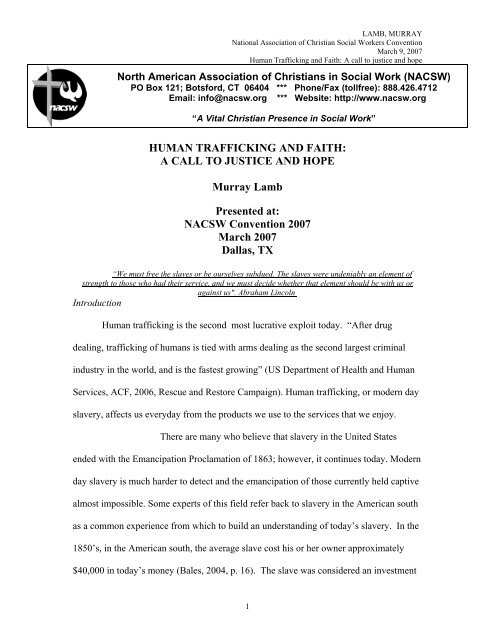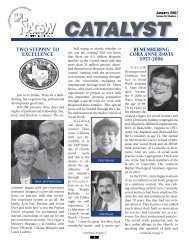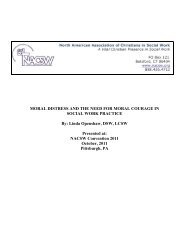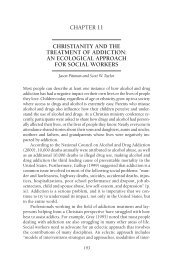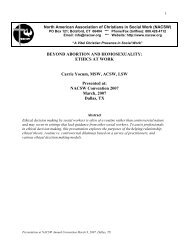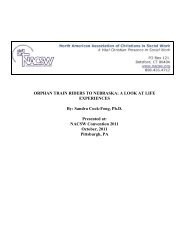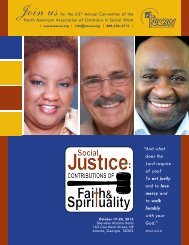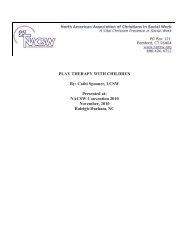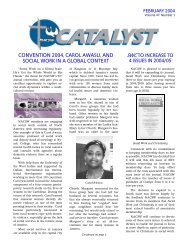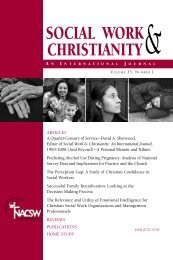HUMAN TRAFFICKING AND FAITH - North American Association of ...
HUMAN TRAFFICKING AND FAITH - North American Association of ...
HUMAN TRAFFICKING AND FAITH - North American Association of ...
Create successful ePaper yourself
Turn your PDF publications into a flip-book with our unique Google optimized e-Paper software.
LAMB, MURRAYNational <strong>Association</strong> <strong>of</strong> Christian Social Workers ConventionMarch 9, 2007Human Trafficking and Faith: A call to justice and hope<strong>North</strong> <strong>American</strong> <strong>Association</strong> <strong>of</strong> Christians in Social Work (NACSW)PO Box 121; Botsford, CT 06404 *** Phone/Fax (tollfree): 888.426.4712Email: info@nacsw.org *** Website: http://www.nacsw.org“A Vital Christian Presence in Social Work”<strong>HUMAN</strong> <strong>TRAFFICKING</strong> <strong>AND</strong> <strong>FAITH</strong>:A CALL TO JUSTICE <strong>AND</strong> HOPEMurray LambPresented at:NACSW Convention 2007March 2007Dallas, TX“We must free the slaves or be ourselves subdued. The slaves were undeniably an element <strong>of</strong>strength to those who had their service, and we must decide whether that element should be with us oragainst us". Abraham LincolnIntroductionHuman trafficking is the second most lucrative exploit today. “After drugdealing, trafficking <strong>of</strong> humans is tied with arms dealing as the second largest criminalindustry in the world, and is the fastest growing” (US Department <strong>of</strong> Health and HumanServices, ACF, 2006, Rescue and Restore Campaign). Human trafficking, or modern dayslavery, affects us everyday from the products we use to the services that we enjoy.There are many who believe that slavery in the United Statesended with the Emancipation Proclamation <strong>of</strong> 1863; however, it continues today. Modernday slavery is much harder to detect and the emancipation <strong>of</strong> those currently held captivealmost impossible. Some experts <strong>of</strong> this field refer back to slavery in the <strong>American</strong> southas a common experience from which to build an understanding <strong>of</strong> today’s slavery. In the1850’s, in the <strong>American</strong> south, the average slave cost his or her owner approximately$40,000 in today’s money (Bales, 2004, p. 16). The slave was considered an investment1
LAMB, MURRAYNational <strong>Association</strong> <strong>of</strong> Christian Social Workers ConventionMarch 9, 2007Human Trafficking and Faith: A call to justice and hopefor the landholder and as such, it was in the slaveholder’s best interest to protect hisinvestment. To do this, laws were passed to help the slaveholder maintain his rights overslaves who were stolen or had run away, and provisions were made for the slaves such ashousing, food and medical treatment (albeit primitive). However, today slaves are muchcheaper. According to Free the Slaves, an anti-slavery non-pr<strong>of</strong>it directed by KevinBales, the average slave today costs just $90 (Freetheslaves.net, 2006, Slavery Today).Today slavery is illegal everywhere and therefore the protection formerly afforded toslaveholders is no longer available and neither is the incentive to protect their“investment”; hence, the title <strong>of</strong> Kevin Bales’ book Disposable People. “Since they areso cheap, slaves are no longer a major investment worth maintaining. If slaves get sick,are injured, outlive their usefulness, or become troublesome to the slaveholder, they aredumped or killed” (Freetheslaves.net, 2006, Slavery Today). Bales (2004) hasestablished that human trafficking as it exists today differs from the slavery that we sawin the <strong>American</strong> South. The following table graphically shows what these differencesare:Old Slavery√ Legal ownershipasserted√ High purchase cost√ Low pr<strong>of</strong>its√ Shortage <strong>of</strong>potential slaves√ Long-termrelationship√ Slaves maintained√ Ethnic differencesimportantNew Slavery√ Legal ownershipavoided√ Very low purchasecost√ Very high pr<strong>of</strong>its√ Glut <strong>of</strong> potentialslaves√ Short-termrelationship√ Slaves disposable√ Ethnic differencesnot important2
LAMB, MURRAYNational <strong>Association</strong> <strong>of</strong> Christian Social Workers ConventionMarch 9, 2007Human Trafficking and Faith: A call to justice and hopeWhat is important to understand from this table is, with the loss <strong>of</strong> seeing aninvestment in their property, slaveholders now can benefit from not taking care <strong>of</strong> theirslaves. As a result, human trafficking has become the second largest organized crimecartel in the world and one <strong>of</strong> the most lethal. Slaveholders can realize extraordinarypr<strong>of</strong>its from an extremely low start-up venture, whereas, as with the slavery the <strong>American</strong>South saw, slavery was tied to such a high start-up investment that slaveholders could notafford to dispose <strong>of</strong> their slaves.While there are many differences between the “old” slavery and today’s slavery,much can be learned from the abolitionists <strong>of</strong> the past who fought to eradicate slaveryfrom the face <strong>of</strong> the earth. At the center <strong>of</strong> the debates <strong>of</strong> the past was the subject <strong>of</strong> Godand His Word in relation to slavery and servitude. Because <strong>of</strong> faith being intertwined inthe debates about slavery, many people <strong>of</strong> faith emerged in the abolition <strong>of</strong> slavery.The names <strong>of</strong> John Newton and William Wilberforce emerge when discussing theabolition <strong>of</strong> slavery in Great Britain. Likewise, the names <strong>of</strong> Sojourner Truth andAngelina E. Grimkè were common names in the abolition movement in the United States.Grimkè (1836) describes, “If slaveholders are determined to hold slaves as long as theycan, let them not dare to say that the God <strong>of</strong> mercy and <strong>of</strong> truth ever sanctioned such asystem <strong>of</strong> cruelty and wrong. It is blasphemy against Him” ( 21). Through her faith,she fought the battle. These men and women <strong>of</strong> faith compel us to act to become acatalyst <strong>of</strong> change today. Learning from abolitionists <strong>of</strong> the past, this paper will exploremodern day slavery, what it is, where it exists, what to do if one should encounter it, andhow the Christian faith intersects at every level <strong>of</strong> human trafficking.Human Trafficking: The Problem3
LAMB, MURRAYNational <strong>Association</strong> <strong>of</strong> Christian Social Workers ConventionMarch 9, 2007Human Trafficking and Faith: A call to justice and hopeThe United States’ State Department estimates between 600,000 to 800,000people are trafficked across international borders every year and <strong>of</strong> those it is estimatedthat approximately 17,500 people are trafficked into the United States annually (U.S.State Department Website, 2006, Office to Monitor and Combat Trafficking in Persons).“In 2002, the DOJ [Department <strong>of</strong> Justice] reports that survivors <strong>of</strong> trafficking whoreceived federal assistance resided in Texas (31%), Florida (19%), and California (14%)(Bales, Fletcher & Stover, 2004, p. 10). According to Free the Slaves (2006), a leadinganti-trafficking NGO (Non-Governmental Organization), there are currently 27 millionslaves in the world.In the United States, it estimated that approximately “…293,000 <strong>American</strong> youthare currently at risk <strong>of</strong> becoming victims <strong>of</strong> commercial sexual exploitation…” (USDOJ,2007, Domestic Sex Trafficking Minors). Many youth who become victims <strong>of</strong>prostitution were abused at home or neglected; others were recruited into their traffickingsituations through abduction, coercion from family, or a false agreement between thetraffickers and the parents (USDOJ, 2007, Domestic Sex Trafficking Minors).Thereasons that these youth are trafficked stem from many <strong>of</strong> the same reasons that peopleare trafficked internationally; lack <strong>of</strong> money, lack <strong>of</strong> resources. “About one-fifth <strong>of</strong> thesechildren become entangled in nationally organized crime networks and are traffickednationally….the average age at which girls first become victims <strong>of</strong> prostitution is 12-14—for boys and transgender youth, the average age <strong>of</strong> entry into prostitution is 11-13”(USDOJ, 2007, Domestic Sex Trafficking Minors).Traffickers are adept at pr<strong>of</strong>iling their potential victims to be able to coerce ormanipulate them into their grasp or knowing how and when to force them into their4
LAMB, MURRAYNational <strong>Association</strong> <strong>of</strong> Christian Social Workers ConventionMarch 9, 2007Human Trafficking and Faith: A call to justice and hopecartels. According to a report completed by Free The Slaves and Human Rights Center,University <strong>of</strong> California, Berkeley, one <strong>of</strong> the case studies <strong>of</strong> the traffickers theyconducted showed that Lakireddy Bali Reddy, a business man who exploited young girlsfrom his hometown in India in California, regularly used “…techniques <strong>of</strong>disempowerment and disconnection to create dependency among the teenage girls hetrafficked into the United States” (Bales, Fletcher & Stover, 2004, p. 37).Obviously, human trafficking exists and is a major issue with which to contend in ourworld today.Human Trafficking: The DefinitionIn 2000, the U.S. congress passed landmark legislation called the TraffickingVictims Protection Act (TVPA) which defined human trafficking within the UnitedStates and provided guidance for the protection against such acts. Later, in 2003, theU.S. congress reauthorized this law. The TVPA also created two new visas, one <strong>of</strong> whichis called the T-Visa and applies specifically to human trafficking victims. The TVPA <strong>of</strong>2003 defined human trafficking as:1) sex trafficking in which a commercial sex act is induced by force, fraud,or coercion or in which the person induced to perform such an act is under18; or2) the recruitment, harboring, transportation, provision, or obtaining <strong>of</strong> aperson for labor or services, through the use <strong>of</strong> force, fraud, or coercionfor the purpose <strong>of</strong> subjecting that person to involuntary servitude,peonage, debt bondage, or slavery (Seltzer, Stewart, Thukral, & Tomatore,2005, p. A-2).5
LAMB, MURRAYNational <strong>Association</strong> <strong>of</strong> Christian Social Workers ConventionMarch 9, 2007Human Trafficking and Faith: A call to justice and hopeSince its inception, the TVPA has provided the means to implement programdevelopment for VOT assistance, allow for joint efforts to be established between theState Department, Department <strong>of</strong> Justice and the Labor Department, and increase publicawareness (ACF, n.d., TVPA Fact Sheet, p. 1-2). The United States remains one <strong>of</strong> theleading nations combating human trafficking and has established a tier system to monitorthe efforts <strong>of</strong> other nations. Additionally, within the United States many states haveimplemented their own anti-trafficking laws and taskforces.Human Trafficking: A Biblical PerspectiveWith the current attention drawn to human trafficking by the United States, onewould think that it is a modern problem. Even the introduction <strong>of</strong> this paper describeshuman trafficking as “modern day slavery.” However, an examination <strong>of</strong> the Biblereveals that human trafficking is not merely a modern concept ("Let My People Go, ThatThey May Serve Me", 2006, p. 3). The Old Testament account <strong>of</strong> Joseph indicates thathe was sold to a group <strong>of</strong> traders by his brothers. He served in Potipher’s house as aslave, and eventually was falsely accused <strong>of</strong> inappropriate activity with Potipher’s wifeand sent to prison. Due to the Lord’s intervention and Joseph’s faithfulness to the Lord,he ended up being second in command to Pharaoh. Years later, due to famine, theIsraelites, Joseph’s people, moved to Egypt and became slaves under Egyptian rule(Genesis 37-47). This single act <strong>of</strong> human trafficking led the entire Israelite people intoslavery. God redeemed His people and used the situation for good, but these events inthe life <strong>of</strong> Joseph reveal to us several concepts about modern day slavery ("Let MyPeople Go, That They May Serve Me, 2006, p. 4).6
LAMB, MURRAYNational <strong>Association</strong> <strong>of</strong> Christian Social Workers ConventionMarch 9, 2007Human Trafficking and Faith: A call to justice and hopeThe first concept is that human trafficking can happen in and around God’speople. Joseph and his family were Israelites, God’s chosen people and yet they were inthe middle <strong>of</strong> a human trafficking situation. The body <strong>of</strong> Christ is neither immune to orexempt from either trafficking or being trafficked. The following story from theAdministration for Children and Families “Look beneath the Surface” DVD (n.d)illustrates this point. Given Kachepa was a young 11 year-old boy from Zambia. He wasbrought to the United States to sing in churches through an all boys choir with thepromise <strong>of</strong> money and education for himself and others in his home country.Tragically,this was not provided deceiving young Given. The people at a church where heperformed became suspicious as they began talking to Given and others in the group.They contacted the authorities and Given began his escape to freedom. From thisexample, it is evident that trafficking can even occur in the church. It can happen bypeople who are using Christ’s name to lure victims. It is a dangerous combination thatunfortunately is destroying lives.Another dimension that Joseph’s story reveals to us is that victims are vulnerableto various manipulations and abuses by their captors. In the case <strong>of</strong> Joseph, he was sentto prison for accusations by Potipher’s wife (Genesis 39). His word was meaningless. Ina similar way, victims today are forced to work <strong>of</strong>f debt that either never existed or aboutwhich they were misinformed. They are indebted and seemingly have no way out <strong>of</strong> theirsituations. As social service providers it is important that we become familiar with thesigns that indicate that someone is experiencing human trafficking so that assistance canbe made available to the potential survivor. (Please refer to the table for an easy guide torecognizing potential trafficking victims.) While trafficking victims are under the control7
Signs: Evidence <strong>of</strong> beingcontrolled Evidence <strong>of</strong> aninability to move orleave one’s job Bruises or othersigns <strong>of</strong> battering Fear or depression Non-Englishspeaking Recently brought tothis country fromEastern Europe,Asia, Latin America,Canada, Africa orIndia Lack <strong>of</strong> passport,immigration oridentificationdocumentationLAMB, MURRAYNational <strong>Association</strong> <strong>of</strong> Christian Social Workers ConventionMarch 9, 2007Human Trafficking and Faith: A call to justice and hope<strong>of</strong> their traffickers, their ability to make independentdecisions and actions is taken from them. Because <strong>of</strong>this, many become dependent on their traffickers forbasic personal care, food and safety; all the while, theyare fearful <strong>of</strong> violence, being sent home with nothing,and harbor feelings <strong>of</strong> “…isolation, shame, andbetrayal” (Bales, Fletcher & Stover, 2004, p. 37).Stockholm Syndrome can be a common experienceamong human trafficking victims. 1 “All <strong>of</strong> theseconditions can cause forced labor victims to lose theirsense <strong>of</strong> control and become increasingly dependent onthose who hold them captive, if merely to survive” (Bales, Fletcher & Stover, 2004, p.37). Typically, VOTs will not readily come forward about their trafficking experience asmany have been conditioned to believe that legal authority and social service providerswill deport them as their immigration status is tied to their trafficker.Finally, Joseph’s story reveals that human trafficking should be examined on amezzo and macro level (groups and communities). Trafficking usually occurs due t<strong>of</strong>amily stressors. In modern day human trafficking usually the economic conditions <strong>of</strong>the family contributes to their motivation to sell their children into slavery, likewise, thejealousy <strong>of</strong> Joseph’s brothers caused them to sell him into slavery (Genesis 37:12-36).1 Stockholm Syndrome according to Wikipedia is defined as: “…a psychological response sometimes seen inan abducted hostage, in which the hostage can show signs <strong>of</strong> having feelings <strong>of</strong> loyalty to the hostage-taker,regardless <strong>of</strong> the danger (or at least risk) in which the hostage has been placed”.8
LAMB, MURRAYNational <strong>Association</strong> <strong>of</strong> Christian Social Workers ConventionMarch 9, 2007Human Trafficking and Faith: A call to justice and hopeKevin Bales on the Free the Slaves website (2006) cites three distinct events thathave contributed to the increase in human trafficking which are all on the mezzo andmacro level. The first event is the recent population explosion around the world. Withsix billion humans on earth the world’s resources are stretched to provide adequately foreveryone; including employment. In many places around the world, people struggle dailyto find necessary elements for survival (food, shelter, safety). In some cases, oneunfortunate event in the family’s or individual’s life results in an appeal to a richlandholder and turns into debt bondage form which the family will never escape. Somepeople are willing to go through extraordinary lengths to escape from their currentconditions and are extremely vulnerable to becoming enslaved. In the United States, onecan see evidence <strong>of</strong> this through the migratory patterns <strong>of</strong> undocumented immigrants whoreach their peril in the Arizonan deserts. Humans will fight for survival, even if it meanstheir enslavement with the promise <strong>of</strong> a better outcome.The second modern event that has lead to an increase in modern slavery ischanges in social and economic situations. As the world’s population grows and people’sability to find resources become more scarce and urbanization grows. People seek moreopportunities in larger cities; however, many <strong>of</strong> the people who have newly settled inurban centers lack job security and power as they typically remain on the outskirts <strong>of</strong>urban centers and cannot assimilate easily into the urban culture.Government corruption is the third event that has lead to an increase in humantrafficking. Though slavery is illegal everywhere, different governments react to slaveryin different ways. Some governments pretend that human trafficking does not exist,while others have created anti-trafficking laws and taskforces to combat its existence.9
LAMB, MURRAYNational <strong>Association</strong> <strong>of</strong> Christian Social Workers ConventionMarch 9, 2007Human Trafficking and Faith: A call to justice and hopeThe US State Department has created a monitoring tool to hold governments accountablefor how they deal with human trafficking. The monitoring tool is a 3 tier system thatevaluates each nation’s commitment to creating anti-trafficking laws, taskforces, or otheranti-trafficking activities. Tier 1 countries have extensive anti-trafficking laws andsystems in place; Tier 2 nations have created some laws but still need some improvementon what they are currently doing. Tier 3 states lack substantial anti-trafficking measuresor have none. The higher the tier the more funding is available to that country to supporttheir anti-trafficking efforts.Blaming the Victim: Not BiblicalDespite these governmental efforts, it is difficult to compel the average person tosee that trafficking is not only a problem, but also not the fault <strong>of</strong> the victim. The OldTestament provides an example <strong>of</strong> how circumstances can cause someone to act outside<strong>of</strong> respected behavior, but be redeemed despite it. Tamar was never trafficked but shedid place herself in a situation in which she sold herself. Tamar was married to one <strong>of</strong>the sons <strong>of</strong> Judah. He was wicked and was killed by his father. Tamar was promised one<strong>of</strong> Judah’s other sons, but never received one in marriage. Therefore, she devised ascheme in which she prostituted herself to her father-in-law. She gave birth to twins andis recorded as one <strong>of</strong> the few women in the lineage <strong>of</strong> Jesus Christ. Judah in realization<strong>of</strong> his wrong doing indicated that, “She is more righteous than I" (Genesis 38). Tamarprostituted herself to gain what was denied her. In the same way women and childrensometimes voluntarily agree to leave their lands and do unthinkable acts because theyhave been denied the basic freedoms and rights that every human is entitled. Theyperhaps live in poverty, see the suffering <strong>of</strong> their families, have no access to education10
LAMB, MURRAYNational <strong>Association</strong> <strong>of</strong> Christian Social Workers ConventionMarch 9, 2007Human Trafficking and Faith: A call to justice and hopedue to their gender and are, thus, hopeless. Another example in the Bible comes from IIKings 4 when a widow comes to the prophet Elisha asking for help because her husbandhas died and the creditors are coming to take her two sons as their slaves. Elisha througha miracle is able to help the women produce enough jars <strong>of</strong> oil to pay <strong>of</strong>f her debt.However, this once again reveals that uncontrollable circumstances can disrupt lives andlead people into slavery.There is a tendency to blame victims for their actions, when in actuality weshould examine the strengths that these victims hold and assist them. The blame shouldbe placed on the mezzo and macro level issues in communities and economies. It shouldalso be placed on the traffickers themselves who pr<strong>of</strong>it from the exploitation <strong>of</strong> the mostvulnerable.Human Trafficking: The Victim’s RightsIn an attempt to place blame where blame is due, trafficking legislation has beencreated to assist not only in the prosecution <strong>of</strong> the traffickers, but also to rehabilitate thetrafficked. A partnership has been established through the state department and theUnited States Catholic Conference <strong>of</strong> Bishops (USCCB). During "Testimony before theHouse Subcommittee on Africa, Global Human Rights and International Operations" onMarch 9, 2005, Julieanne Duncan, Ph.D., the Director <strong>of</strong> the Office <strong>of</strong> Children's Servicesfor USCCB Migration and Refugee Services states:The Catholic bishops <strong>of</strong> the United States and the church communitythroughout the nation have placed combating human trafficking as a toppriority in their public advocacy, educational outreach, and in providingservice to trafficking victims. From the Catholic perspective, human11
LAMB, MURRAYNational <strong>Association</strong> <strong>of</strong> Christian Social Workers ConventionMarch 9, 2007Human Trafficking and Faith: A call to justice and hopetrafficking represents a scourge on the earth which must be eradicated. Itis indeed troubling that in the twenty-first century human beings are beingsold into bondage as prostitutes, domestic workers, child laborers, andchild soldiers.These are intense words spoken by a representative <strong>of</strong> the organization. This sentimenthas trickled down into the Catholic Charities agencies which Can you leaveprovide direct services to the victims <strong>of</strong> human trafficking.The mission statement <strong>of</strong> Catholic Charities is to“provide service to those in need, to advocate compassion andjustice in all structures <strong>of</strong> society and to call all people <strong>of</strong> goodwill to do the same” (Catholic Charities Of Fort Worth, n.d.,Get to Know Us). This mission <strong>of</strong> the agency drives it toserve victims <strong>of</strong> trafficking and to educate parishes andcommunities about the problem. The mission is rooted in afaith in Jesus Christ. Through this faith, such values becomepart <strong>of</strong> the work <strong>of</strong> the agency and guide it to serve the mostvulnerable in the community. One <strong>of</strong> the most vulnerablepopulations, in this case human trafficking victims, is providedyour work or jobsituation if you want? When you arenot working, can youcome and go as youplease? Have you beenthreatened with harmif you try to quit? Has anyonethreatened yourfamily? What are youworking conditionslike? Where do yousleep and eat? Do you have t oasked permission toeat, sleep or go to thebathroom? Is there a lock onyour door or windowsso you cannot get out?an array <strong>of</strong> services. Catholic Charities Diocese <strong>of</strong> Fort Worth, Inc. provides casemanagement, financial assistance, employment assistance, English as a SecondLanguage, civics classes, immigration assistance (for adjustments <strong>of</strong> status; applicationfor residual T-Visas), and counseling. The United States Conference <strong>of</strong> Catholic Bishopsalso provides funds for similar assistance to other faith-based organizations and non-12
LAMB, MURRAYNational <strong>Association</strong> <strong>of</strong> Christian Social Workers ConventionMarch 9, 2007Human Trafficking and Faith: A call to justice and hopepr<strong>of</strong>its. An example <strong>of</strong> another Victim <strong>of</strong> Trafficking serving agency is Mosaic familyservices. Since services and shelters are readily available, the task <strong>of</strong> identifying victims<strong>of</strong> trafficking is now essential.It is important that as social service providers we inform them <strong>of</strong> their rights inthe United States. Many victims will not speak English or understand U.S. culture orcustoms. Therefore, it is important that appropriate language and cultural sensitivity beexhibited. Under Title VI <strong>of</strong> the Civil Rights Act <strong>of</strong> 1964, it is illegal to discriminateagainst people based on their national origin which includes language (DOJ, 2003,Coordination and Review Section). Because <strong>of</strong> the sensitive nature <strong>of</strong> the victim’ssituation, providing pr<strong>of</strong>essional language services is essential. To initiate immediateservices to the survivor it is important to gain their trust as much as possible. Accordingto the U.S. Department <strong>of</strong> Health and Human Services Administration for Children andFamilies’ “Look beneath the Surface” training, there are some communication techniquesthat may assist the social service provider gain the survivor’s trust. Please see theillustration box. Once it seems as if the person is a survivor and after discussing it withthe survivor, immediately call (888) 428-7581, or 911 to get the survivor connected to theappropriate resources.Human Trafficking: Agency VulnerabilitiesThe U.S. NASW’s COE tells us that we have ethical principals, <strong>of</strong> which, thereare 6 (NASW, 2007, COE). Though all <strong>of</strong> them are equally important, there are 4 thatparticularly stand out in relation to social workers working with this population. We arecalled to serve all those in need and address social problems. We are also called toadvocate for social justice particularly on behalf <strong>of</strong> those most vulnerable in our society.13
LAMB, MURRAYNational <strong>Association</strong> <strong>of</strong> Christian Social Workers ConventionMarch 9, 2007Human Trafficking and Faith: A call to justice and hopeOur trustworthiness is called upon to ensure quality services to individuals, which usuallymeans that clients feel that they can trust their social worker more than other people intheir lives. Maintaining our competency to be able to ethically serve our clients isparamount in our work, especially when dealing with VOTs as this field is fairly new andunderstudied. The treatment <strong>of</strong> VOTs is constantly evolving and people are learning newtechniques everyday. These ethical principals are what guide us through our code <strong>of</strong>ethics standards. They are what compel us to do our jobs. However, occasionally theycan present some sticky situations for the pr<strong>of</strong>essional social worker.One <strong>of</strong> the biggest areas <strong>of</strong> vulnerability for social workers and social serviceagencies is with respect to confidentiality and client privilege. Social workers are boundby confidentiality unless the client is a threat to themselves or others or the social workerneeds to report child abuse. Breaking confidentiality requires written consent from theclient. Breaking confidentiality without consent has severe consequences for the socialworker and the client. What should one do in a situation in which the client divulges tothe social worker intimate details about his or her trafficking? In many states there is nosocial worker/client privilege to protect that information. Technically, if the client tellshis or her story to the social worker that information cannot be confidential as the casenotes that the social worker is required to maintain can and will be subpoenaed, and thus,may help the defense to discredit the client's testimony. The level <strong>of</strong> protection <strong>of</strong> theclient’s records depends on the level <strong>of</strong> pr<strong>of</strong>essional credentials the social workerpossesses, the level <strong>of</strong> expectation <strong>of</strong> the client for confidentiality, and the purposes forthe communication (Seltzer, et al., 2005, p. A-7). The fact that client privilege is not wellestablished in many states presents a complicated and unclear matrix for providing14
LAMB, MURRAYNational <strong>Association</strong> <strong>of</strong> Christian Social Workers ConventionMarch 9, 2007Human Trafficking and Faith: A call to justice and hopeservices to clients. “Therefore, social workers, and social service organizations need totake every precaution to protect client's communications, and/or to advise clients thatsuch communication may not be confidential” (Seltzer, et al., 2005, p. A-7).Interpreters are one <strong>of</strong> the few exceptions to this rule. If the social worker oranother assistant is acting solely as an interpreter in this context, a third party may bepresent (Seltzer, et al., 2005, p. A-7). It is essential that interpreters be used when dealingwith VOTs. Not only is it their right under Title IV <strong>of</strong> the Civil Rights Act <strong>of</strong> 1964, but itis important to understand how to best serve the client. They will have extensive medicalissues ranging from malnutrition to sexually transmitted diseases that need immediateattention. They will have psychological needs to be promptly addressed. And they havetheir stories to tell if they so choose. The facilitation <strong>of</strong> all <strong>of</strong> this may require apr<strong>of</strong>essional interpreter. Using pr<strong>of</strong>essionally trained interpreters ensures that they willabide by a COE very similar to the NASW’s and ensures quality services. If one is notavailable to you, ATT Language Line is also available.The competence <strong>of</strong> the social worker is challenged with regards to pr<strong>of</strong>essionalprivilege. One way to ensure that the client’s information is protected is to ensure thatanother pr<strong>of</strong>essional privilege is available such as the client’s attorney or their therapist.However, these privileges are only protected between the client and the attorney ortherapist. If a third party is in the room, confidentiality can be considered broken(Seltzer, et al., 2005, p. A-7).If your client is at a point when they can tell their story, explain to them that youwant to protect their interests and their integrity, so you need them to tell their attorney.15
LAMB, MURRAYNational <strong>Association</strong> <strong>of</strong> Christian Social Workers ConventionMarch 9, 2007Human Trafficking and Faith: A call to justice and hopeFrom the first session with the client, explain to them the limits <strong>of</strong> your pr<strong>of</strong>essionalduties, obligations and privileges so that they will not feel that you are undermining theirtrust with you. By doing this, you are giving them their rights back to decide what is bestfor them, and telling them that you value them as a person.Realize the limits <strong>of</strong> your pr<strong>of</strong>essional licensure and responsibility to ensure thatquality services are afforded to the survivor. There are many resources available toproviders involved with VOT cases, if you need help or have questions, ask. If you areunsure <strong>of</strong> what your pr<strong>of</strong>essional responsibilities and/or limitations are, call your statelicensure board and seek-out local anti-trafficking taskforces with which to get involved.Your files and case notes can and will be subpoenaed; thus, may help the defenseto discredit the client’s testimony. The files should be kept in extremely securelocations. Try to ensure that your files are secure from every angle. Keep only essentialinformation that you need in the file—try to have the intakes done with an attorneypresent. Case notes should be clear and explain exactly what happened in the session.Traffickers are extremely adept at getting information about the client. When theclient is in a safe location awaiting their continued presence or T-Visa, they may still bein contact with their traffickers. It is extremely important that the client understand thatthey cannot under any circumstances divulge their location to anyone. The creation <strong>of</strong> asafety plan is essential at the beginning <strong>of</strong> services to ensure that the client is safe andthat others around the client are safe as well. Safety planning is something that the clientneeds to develop for themselves. They also need to have an understanding <strong>of</strong> theirresponsibilities to the agency and others around them. It is also an opportunity for the16
LAMB, MURRAYNational <strong>Association</strong> <strong>of</strong> Christian Social Workers ConventionMarch 9, 2007Human Trafficking and Faith: A call to justice and hopeagency to develop a trusting relationship with the individual so that independence can begained more quickly.Working with VOTs while there is still a trial going on means that their traffickersare still at large and it is therefore extremely important that you continually review thesafety plan, labor rights and laws, and that you are acting well within your pr<strong>of</strong>essionalduties. Never talk about or give out information about the VOT to people unless youpersonally know them and know that they are legitimately involved in your client’scase—the person may be the VOTs trafficker trying to locate them. Because <strong>of</strong> the trialsituation, your case notes will have a higher probability <strong>of</strong> being subpoenaed.Human Trafficking: A Call to ActNow that we have given you tools to identify traffickers, it is essential to take alook at what the Christian faith compels us to do about it! The Old Testament gives us aglimpse <strong>of</strong> the problem <strong>of</strong> slavery, while the New Testament through Jesus Christproclaims freedom for the slaves or prisoners. Isaiah 61 is a prophecy about Christ whichtells us that His goal or purpose was “to proclaim freedom for the captives and releasefrom the darkness for the prisoners” (Isaiah 61:1). It is also a calling to us to help in theabolition <strong>of</strong> slavery. In Galatians, Paul writes that “there is neither Greek nor Jew, slavenor free, we are all one in Christ Jesus” (Galations 3:28). Because <strong>of</strong> Christ, there is nohierarchy <strong>of</strong> power or control. In His eyes we are equal. We are to look at the victims asbeing equal to ourselves. Not only are we to consider trafficking victims as equals, weare to go much further and in Philippians Paul urges the church to, “in humility considerothers better than yourselves.” (Philippians 2:3) In doing this as Christ describes inMatthew 25:40, we will be assisting Christ himself. “Truly, I say to you, as you did it to17
LAMB, MURRAYNational <strong>Association</strong> <strong>of</strong> Christian Social Workers ConventionMarch 9, 2007Human Trafficking and Faith: A call to justice and hopeone <strong>of</strong> the least <strong>of</strong> these my brothers, you did it to me.” From this it is evident, that asbelievers in Jesus Christ we are called to participate in the freeing <strong>of</strong> slaves, to give tomeet their needs and to be <strong>of</strong> service to them.There are men and women <strong>of</strong> faith who understood this calling to participate inthe movement <strong>of</strong> abolition. Some <strong>of</strong> them were former slave owners and some slavesthemselves, but the common denominator in their abolition efforts were theirunderstanding that God had called them to do something.One <strong>of</strong> the greatest names in Great Britain for the abolition <strong>of</strong> the African SlaveTrade is William Wilberforce. John Piper in his Reflections on the Life and Labor <strong>of</strong>William Wilberforce, wrote, “One year after his conversion God’s apparent calling on hislife had become clear to him. On October 28, 1787, he wrote in his diary, ‘God Almightyhas set before me two great objects the suppression <strong>of</strong> the Slave Trade and theReformation <strong>of</strong> Manners." Wilberforce used his position in the Parliament to take on thecause <strong>of</strong> Abolition. After 20 years <strong>of</strong> treacherous work the African Slave Trade wasabolished; and 26 years after that, three days before Wilberforce’s death, slavery itself inGreat Britain was abolished. Wilberforce never gave up the fight. It was his life’scalling. The battle was not only long, but treacherous as many obstacles were set beforehim. Similarly, to abolish human trafficking today, the road will be long and treacherous.The life <strong>of</strong> Wilberforce rings truth into the verse in Esther 4:14 which says, “And whoknows but that you have come to royal position for such a time as this?”Another life that is marked by faith is that <strong>of</strong> Sojourner Truth or IsabellaBaumfree, a former African slave in the United States. Isabella Baumfree changed hername after she felt a calling on her life to travel around the United States, reveal to people18
LAMB, MURRAYNational <strong>Association</strong> <strong>of</strong> Christian Social Workers ConventionMarch 9, 2007Human Trafficking and Faith: A call to justice and hopetheir sin and proclaim the truth to them. During this time, she became involved in theabolition movement and became infamous for the words, “Fredrick, Is God dead?” Itwas these words that silenced a crowd who had just heard from Fredrick Douglass whowas encouraging the group to take up arms and fight to end slavery. It was Sojourner’swords that turned people to God for help and gave them hope that violence did not haveto be the answer at that time. “She consistently pointed her audiences to God—knowingthat the only way people can solve such complex problems is to turn to Jesus Christ forthe answer” (Mac and Tait, 2004, p. 174). She fought not only for the end <strong>of</strong> slavery, butalso for civil rights and for women’s rights. Her words were pr<strong>of</strong>ound and always left animpact.Finally, there is Angelina E. Grimkè, who grew up in a family who owned slavesand later became one <strong>of</strong> the greatest abolitionist and advocates for slaves. Mac and Tait(2004) say, “When she spoke <strong>of</strong> the sound <strong>of</strong> the lash, the cry <strong>of</strong> the slave, those imagescame not from a neighboring plantation but from her own upbringing” (p. 226).Angelina’s sister Sarah after traveling north, is the person who revealed to Angelina theevil <strong>of</strong> slavery. Angelina soon realized its inhumanity and joined the Female Anti-Slavery Society. “For Angelina, her abolitionist views were not just an emotional feelingor a reasoned opinion; they were fully derived from her faith as a Christian woman.Slavery was appalling to God, a sin from which our country needed cleansing andpossibly even saving (Mac and Tait, 2004, p. 227). Angelina felt so strongly that slaverywas against God’s desires that she wrote and spoke to women across the country to takeaction. In a paper entitled, “Appeal to The Christian Women <strong>of</strong> the South” (1836), shewrote pages and pages describing the scriptures that dealt with slavery. Because the19
LAMB, MURRAYNational <strong>Association</strong> <strong>of</strong> Christian Social Workers ConventionMarch 9, 2007Human Trafficking and Faith: A call to justice and hopeSouth was using the Christian faith as a means to promote slavery, she used the veryWord <strong>of</strong> God to denounce it. Her appeal was for Christian women to search theScriptures and see for themselves that slavery was wrong and not from God. She thenencouraged them to pray and act in the movement. From her paper, there can be foundfour ways in which people can begin to act based on their faith to “free the captives” andend modern day slavery, human trafficking.First, she encourages people to “read on the subject” (Grimke, 1836, 31) Thefirst place that she encourages reading is in the scriptures. Search whether humantrafficking or slavery is biblical based on the teachings <strong>of</strong> the Old Testament and that <strong>of</strong>Jesus Christ in the New Testament. After studying the scriptures, read more about humantrafficking. There are several internet websites such as www. Humantrafficking.comwww.freetheslaves.org and www.acf.gov/humantrafficking. There are also several booksthat maybe helpful such as Disposable People (2004) by Kevin Bales, and Newton: TheLiberator (1981) by J. Pollock.After reading on the subject, she encourages people to “pray over this subject”(Grimke, 1836, 32). The Bible says in Ephesians 6:18, “And pray in the Spirit on alloccasions, with all kinds <strong>of</strong> prayers and requests. With this in mind, be alert and alwayskeep on praying for all the saints.” Angelina talks about praying for the slaves, for theslaveholders, for those who are currently fighting against slavery. This is a good start tobegin praying. Several agencies also provide prayer guides for those who want to get acongregation or small group involved in praying. These organizations include theSalvation Army, the Evangelical Alliance, and Make Way Partners Corporation. Prayeron an individual and corporate level begins to align individual’s hearts with God’s.20
LAMB, MURRAYNational <strong>Association</strong> <strong>of</strong> Christian Social Workers ConventionMarch 9, 2007Human Trafficking and Faith: A call to justice and hopeThirdly, Angelina encourages followers <strong>of</strong> Christ to “Speak on the subject”(Grimke, 1836, 33). She says that, “It is through the tongue, the pen, and the press, thattruth is principally propagated” (Grimke, 1836, 33). One would imagine that she meantspeak to the masses, gather the people and proclaim the truth. However, she just meantto speak among one’s everyday acquaintances. Speak to family and friends. Bring uphuman trafficking; see if they have heard about it. Teach them what you have studiedand read. Inform them on the prevalence <strong>of</strong> the matter and let your heart be known tothem.Finally, Angelina encourages everyone to “Act on the subject”. In acting, shemeant immediate action. Free the slaves if you own them. Take care <strong>of</strong> former slaves ifthey are in your midst. And in the same way, Christians should take the stand againstmodern day slavery and act to end it. Grimke (1836) says, “You must take it up onChristian ground, and fight against it with Christian weapons, whilst your feet are shodwith the preparation <strong>of</strong> the gospel <strong>of</strong> peace” ( 48). There are many ways in whichsomeone can act today in the abolition <strong>of</strong> modern day slavery. Writing and informingone’s representatives on the issues and needs <strong>of</strong> trafficking laws and services to victims isone step. Another is to volunteer in a non-pr<strong>of</strong>it or faith-based organization that ishelping victims <strong>of</strong> trafficking rebuild their lives here in this country. There are severalorganizations working in the abolition <strong>of</strong> slavery that could use financial support such asan organization known as Loose Change to Loosen Changes which was started by ayoung boy. The opportunities are endless. The question is what will you do to act?Conclusion:21
LAMB, MURRAYNational <strong>Association</strong> <strong>of</strong> Christian Social Workers ConventionMarch 9, 2007Human Trafficking and Faith: A call to justice and hopeAs people <strong>of</strong> faith, we are called upon to expose one <strong>of</strong> the world’s most heinousexploits—human slavery. Following Angelina Grimike’s example, we have learnedmore about what human trafficking is, where it is, and what to do about it. With nearlyone million people in transit every year and 27 million people currently enslaved, we asGod’s children cannot sit idle. Love your neighbor as you love yourself—simple wordsthat remind us <strong>of</strong> our responsibilities as global citizens.The author’s close this discussion with a challenge: How much would you payfor your freedom? Now, what will you do for the freedom <strong>of</strong> others?22
LAMB, MURRAYNational <strong>Association</strong> <strong>of</strong> Christian Social Workers ConventionMarch 9, 2007Human Trafficking and Faith: A call to justice and hopeReferences:Bales, K. (2004). Disposable People: New Slavery in the global economy. Berkley, CA:University <strong>of</strong> California Press.Bales, K., Fletcher, L. & Stover, E. (2004, September). Hidden Slaves: Force Labor inthe United States. Free the Slaves, Washington, D.C. and Human Rights Center,University <strong>of</strong> California, Berkley.Buller, C. (2006). Human Dignity versus Human Trafficking. Retrieved September 19,2006, from Salvation Army: http://www.salvationarmyusa.org/usn/www_usn.nsf/vw-sublinks/5F25C4FD342C33358025718E00653E51?openDocumentCatholic Charities Diocese <strong>of</strong> Fort Worth. (n.d.) Information retrieved February 21, 2007from: http://www.ccd<strong>of</strong>w.org/get_to_know.html.Free The Slaves (2006). Information retrieved November 2006-Janurary 2007 from:http://www.freetheslaves.net/.Grimkè, A. (1836). Appeal To The Christian Women <strong>of</strong> the South. Retrieved fromhttp://history.furman.edu/~benson/docs/grimke2.htmMac, T. and Tait, M. (2004). Under God. Minneapolis, Minnesota: Bethany HousePublishers.NASW. (2007). Code <strong>of</strong> Ethics. Retrieved February 21, 2007 from:http://www.socialworkers.org/pubs/code/code.asp.Piper, J. (2002). Peculiar Doctrines, Public Morals, and the Political Welfare:Reflections on the Life and Labor <strong>of</strong> William Wilberforce. Retrieved December 6,23
LAMB, MURRAYNational <strong>Association</strong> <strong>of</strong> Christian Social Workers ConventionMarch 9, 2007Human Trafficking and Faith: A call to justice and hope2006, from http://desiringgod.org/ResourceLibrary/Biographies/1492_Peculiar_Docrines_Public_MPollock, J. (1981). Newton: The Liberator. Eastborne, England: KingswayCommunications Ltd.Seltzer, S., Stewart, C., Thukral, J. & Tomatore, S. (2005, March). Identification andLegal Advocacy for Trafficking Victims (2 nd edition). New York: Dechert LLP.Testimony before the House Subcommittee on Africa, Global Human Rights andInternational Operations (March 9, 2005). Retrieved September 19, 2006, fromhttp://www.nccbuscc.org/mrs/tvpra2005jd.shtmlhttp://www.state.gov/g/tip/.The NIV Study Bible (1995). Grand Rapids, MI: Zondervan Publishing HouseThompson, L. (2006). Let My People Go, That They May Serve Me. Retrievedfrom Salvation Army: http://www.salvationarmyusa.org/usn/www_usn.nsf/vwsublinks/5F25C4FD342C33358025718E00653E51?openDocumentU.S. Department <strong>of</strong> Health and Human Services (n.d.) Trafficking Victims Protection Act<strong>of</strong> 2000 Fact Sheet. Retrieved on February 21, 2007 from:http://www.acf.hhs.gov/trafficking/about/TVPA_2000.pdf.U.S. Department <strong>of</strong> Health and Human Services (2007). Rescue and Restore Campaign.Information retrieved November 2006-Febrary 2007 from:http://www.acf.hhs.gov/trafficking/campaign_kits/tool_kit_social/social_service.ppt.U.S. Department <strong>of</strong> Justice (2003). Civil Rights Division. Information retrieved onFebruary 21, 2007 from: http://www.usdoj.gov/crt/cor/coord/titlevi.htm.24
LAMB, MURRAYNational <strong>Association</strong> <strong>of</strong> Christian Social Workers ConventionMarch 9, 2007Human Trafficking and Faith: A call to justice and hopeU.S. Department <strong>of</strong> Justice. (2007). Domestic Sex Trafficking <strong>of</strong> Minors (CEOS).Retrieved on January 22, 2007 from:http://www.usdoj.gov/criminal/ceos/prostitution.html.U.S. Department <strong>of</strong> State (2006), Office to Monitor and Combat Trafficking in Persons.Information retrieved November 2006 through January 2007 from:.25


